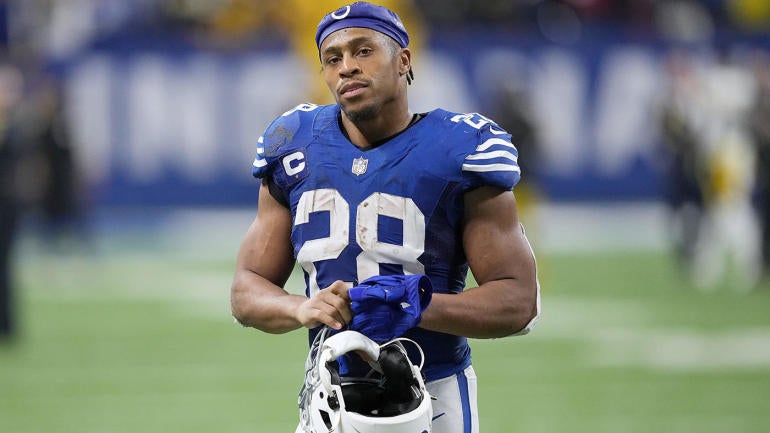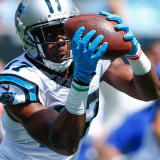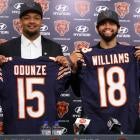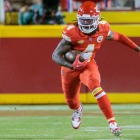
A long time ago in a galaxy far, far away … running back was the most valuable position in the NFL.
In 1989, the Cowboys received NINE picks (including three first-round selections) and five players from the Vikings for Herschel Walker. Fast forward to 2022 when the 49ers parted with a second-, third-, fourth- and fifth-round pick for Christian McCaffrey. Chump change compared with the behemoth Walker deal.
For a short three days in July of 1997, Lions running back Barry Sanders was the highest-paid player (not just running back) in the NFL, as the two sides reportedly agreed to a deal that would pay him an average of $5.76 million, surpassing three-time Super Bowl-winning quarterback Troy Aikman ($5.67 million) as the highest-paid player in the entire league.
Three days later, Sanders' deal was not approved by the league and it had to be renegotiated. For those three days though, a running back -- I repeat, a running back -- was reportedly the highest paid player in the NFL. Times have certainly changed as today running backs around the league are up in arms over their value. The highest-paid back is McCaffrey, whose $16 million per year ranks 110th among all positions.
Last week, Steelers GM Omar Khan pointed to massive new QB contracts as a reason why RBs are becoming devalued. To his point, the RB franchise tag is worth less now ($10.09 million) than it was in 2015 ($10.95 million) while every other position, including QB ($18.5 million to $32.4 million) has gone up significantly. Keep in mind the salary cap has increased from from $143 million to $225 million in that span
Our Tyler Sullivan recently laid out the many reasons RBs are frustrated, which includes the above franchise tag valuations. Not to mention:
- None of the three franchise-tagged backs (Josh Jacobs, Saquon Barkley, Tony Pollard) got long-term deals.
- Joe Mixon and Aaron Jones took pay cuts this offseason.
- Austin Ekeler requested a trade before agreeing to a restructured deal.
- Dalvin Cook, Ezekiel Elliott and Leonard Fournette were released this offseason and remain unsigned.
Star running backs were so displeased they met on Zoom last week to talk about the financial state of the position. No concrete plans formed from the meeting.
And the latest development, Jonathan Taylor requested a trade from the Colts and the team is reportedly considering placing him on the non-football injury list with a back injury he denies.
We can all understand why running backs are upset. Their value is going down despite still being among the most exciting players to watch, who still touch the ball a ton, while taking a lot of punishment.
So why has the important position become less valuable?
Colts owner Jim Irsay put it bluntly: "If I die tonight and Jonathan Taylor is out of the league, no one's gonna miss us. The league goes on. We know that. The National Football [League] rolls on. It doesn't matter who comes and who goes, and it's a privilege to be a part of it."
It's an extreme view and terribly put, but still gets at the heart of the matter. RBs aren't as valuable as they used to be. They have become more expendable in a passing league, there's little correlation between high-paid RBs and winning, plus they have a shorter career span.
RBs have become more expendable
One reason Irsay made that claim about Taylor? He's been there. The Colts have moved on from Marshall Faulk and Edgerrin James in the last quarter century without issue. It's a similar trend around the league when you look at big-name RBs to change teams in their prime.
- The Patriots won a Super Bowl four years after Curtis Martin went to the Jets in 1998.
- The Colts drafted Edgerrin James after trading Marshall Faulk in 1999 and went from 3-13 to 13-3.
- The Saints went from 7-9 to 9-7 after trading Ricky Williams to the Dolphins in 2002.
- The Bengals went from 8-8 to 8-8 after trading Corey Dillon to the Patriots in 2004.
- The Broncos made the AFC title game two years after trading Clinton Portis for Champ Bailey in 2004.
- The Colts won the Super Bowl in 2006 after letting Edgerrin James go in free agency and drafting Joseph Addai.
- The Ravens made the AFC title game the second season after releasing Jamal Lewis in 2007.
- The Cowboys went 13-3 the second season after DeMarco Murray signed with the Eagles in free agency. Drafting Ezekiel Elliott and Dak Prescott helped.
- The Eagles won a Super Bowl in their third season after trading LeSean McCoy to the Bills.
- The Steelers have not won a playoff game since Le'Veon Bell's contract dispute in 2018. His results with the Jets are still proof they made a wise decision though.
- The Panthers had a better record after trading Christian McCaffrey in 2022.
The slow death of the workhorse running back has also made the position more expendable. Only three RBs accounted for at least 30 percent of their team's scrimmage yards in 2022: Derrick Henry, Josh Jacobs and Christian McCaffrey. That number was 12 in 2000.
Paying RBs doesn't equal success
If giving running backs big contracts was tied to winning playoff games and championships, the RB market would look different. But it's not.
You've probably heard this before, RB isn't a premium position in a passing league. Those positions would be the players who throw the ball (QB), catch the ball (WR), protect the passer (OT), rush the passer (EDGE) and those who defend passes (CB).
Today's NFL market reflects that for good reason. I looked at the top 10 highest cap hits at each position over the last 10 seasons, and:
- Teams who employ a RB with a top 10 cap hit collectively have a record just above .500 in that span, the worst among those six position groups.
- Thirty-seven percent of top 10 paid RBs make the playoffs, the worst rate among those six position groups.
- The average offensive efficiency rank among teams with top 10 paid RBs is 17th, below the league average, the worst unit rating among those six position groups.
| Leaguewide numbers among top 10 highest cap hits at position | Team Win pct | Team Playoff pct |
|---|---|---|
EDGE | .548 | 48% |
QB | .542 | 48% |
OT | .523 | 44% |
WR | .514 | 39% |
CB | .513 | 41% |
RB | .506 | 37% |
The last RB with a top 10 cap hit at the position to win a title was Marshawn Lynch in 2013. Since the Seahawks beat the Broncos in the Super Bowl to cap the 2013 season, no Super Bowl winner has had a leading rusher with a cap hit over $2 million.
| Cap Hit by Leading Rusher on Super Bowl Winners | Last 10 Seasons |
|---|---|
Isiah Pacheco (2022 Chiefs) | $725K |
Sony Michel (2021 Rams) | $1.7M |
Ronald Jones (2020 Buccaneers) | $1.9M |
Damien Williams (2019 Chiefs) | $1.7M |
Sony Michel (2018 Patriots) | $1.8M |
LeGarrette Blount (2017 Eagles) | $1.3M |
LeGarrette Blount (2016 Patriots) | $1.0M |
Ronnie Hillman (2015 Broncos) | $943K |
Jonas Gray (2014 Patriots) | $273K |
Marshawn Lynch (2013 Seahawks) | $8.5M |
You don't need a traditional superstar back to win. Nobody has won a rushing title and a championship in the same season since Terrell Davis in 1998.
The last player to rush for 1,000 yards and win a Super Bowl in the same season was LeGarrette Blount for the 2016 Patriots. As you can imagine, this used to be commonplace. We are a long way from the '90s when legends like Thurman Thomas, Emmitt Smith, Terrell Davis and Marshall Faulk were on the biggest stage.
| 1,000-Yard Rushers on Super Bowl Winners by Decade | ||
|---|---|---|
2010s | 3 | LeGarrette Blount, Marshawn Lynch, Ray Rice |
2000s | 6 | Brandon Jacobs, Joseph Addai, Willie Parker, Corey Dillon, Antowain Smith, Jamal Lewis |
1990s | 7 | Marshall Faulk, Terrell Davis (twice), Emmitt Smith (three times), Earnest Byner |
1980s | 6 | Roger Craig (twice), Walter Payton, Marcus Allen, Wendell Tyler, Joe Morris |
1970s | 9 | Franco Harris (four times), Tony Dorsett, Mark van Eeghen, Larry Csonka (twice), Mercury Morris |
Running a lot doesn't equal success
Teams that rely on running the most aren't winning more. I looked at the teams with the five highest first-half run rates in each of the last 10 seasons. Collectively, they have a losing record. Those five teams were a combined 34-50-1 last year.
The last team to lead the NFL in rushing yards and win a Super Bowl in the same year? The 1985 Bears.
Too many veteran RB contracts have flopped
Another reason the RB position is devalued is because it has the shortest shelf life of any position in the NFL. That's been proved by the bad contracts handed out to veteran RBs in recent years.
In case you need a reminder on the biggest flops:
- Ezekiel Elliott was released this offseason (and remains unsigned) after he finished last in the NFL in yards per touch (3.9) in 2022 and clearly looked like a shell of his former self. He was set to enter the fifth year of a six-year deal.
- Todd Gurley was released two years into a four-year, $60 million deal after a down year in 2019. He played one more season in his career.
- Le'Veon Bell was released by the Jets halfway through the second year of a four-year deal worth $53 million.
Don't even get me started on the Shaun Alexander deal in 2006 and the Larry Johnson contract in 2007.
A deeper look at the 20 largest contracts ever given to veteran running backs (in terms of guarantees) supports the buyer beware sentiment.
Of the 16 completed deals, only three players actually played the full length of the deal with the team that signed him: Adrian Peterson, Steven Jackson and Jonathan Stewart.
If you look at the collective efforts of those 20 deals you'll see a decline in returns from what they did over their rookie deals.
| Average Season of Top 20 Largest Veteran RB Contracts in NFL History | Rookie Deal Averages | |
|---|---|---|
Scrimmage yards | 1,206 | 1,409 |
Touchdowns | 7.9 | 9.8 |
Yards per touch | 4.8 | 5.4 |
Solution: Better performance on second contracts and add more value in passing game
The best way for RBs to increase their value is to play better on these second contracts. Last week, I wrote about how the recent wave of veteran deals since the Ezekiel Elliott contract could actually slowly be turning the tide. Seven RBs (Joe Mixon, Aaron Jones, Alvin Kamara, Christian McCaffrey, Dalvin Cook, Derrick Henry and Nick Chubb) have signed deals worth at least $10 million annually since the Elliott deal. The group has collectively outproduced compared with their rookie deals, bucking the above trend.
McCaffrey serves as an interesting poster boy for both the problems and solutions facing RBs today. He's the highest-paid running back in the NFL, but missed 23 games from 2020-21. He also flashed MVP potential for the 49ers last year while doing just about everything.
49ers GM John Lynch sees his value. "Could we play without our guy? I think we could. Do we want to? No," Lynch added via ProFootballTalk. "That's why we paid so much to go get him. And I credit Christian. He's not just a running back. He's a lot of things for us and we talk about him unlocking our offense. So, I'm just fortunate that we have a guy that can do that. And I think when we have a guy that can do that, it inspires the other backs to not just become running backs, to work on all facets of their game. And when you do that, you become more than just that."
The solution of running backs becoming more valuable in a passing league isn't happening as much as you'd expect. RBs accounted for 15 percent of all receiving yards throughout the league in 2022, the second-lowest rate since 2000, behind 2020. Considering the rate was 20 percent back in 2000, they're moving backward.
The position is also ceding ground in the run game. Running backs accounted for 79 percent of the league's rushing yards in 2022, down from 83 percent in 2000. QBs are running more and even slowly taking that away from RBs.
Running backs still accounted for 37 percent of the league's yards in 2022. It makes sense why they are frustrated with their value. It also makes sense why teams aren't willing to pay veteran RBs more. Hence the current standstill with many household names at the position.
In a way it's like natural selection. We'll see if RBs can better adapt to today's NFL. Until then, there'll be more fireworks like the ones coming from Jonathan Taylor and Jim Irsay.






















